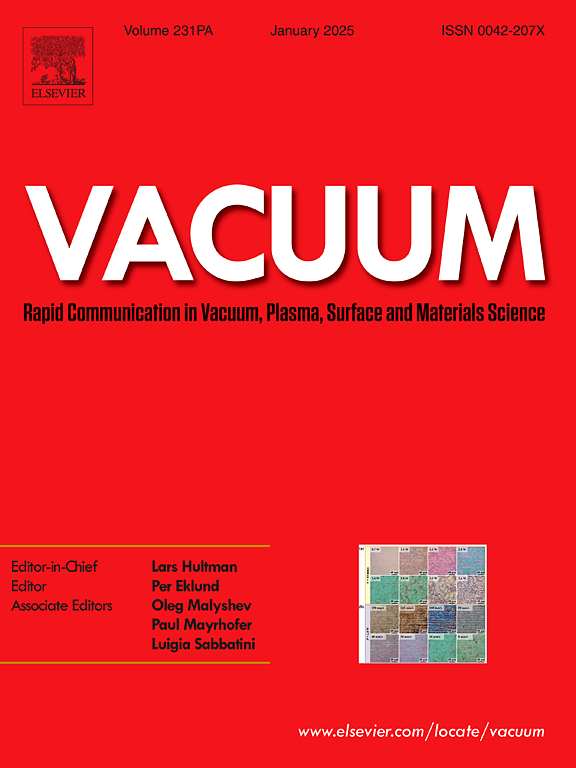Surface modification approach to improve the secondary electron emission properties of Al and Au Co-doped MgO film
IF 3.8
2区 材料科学
Q2 MATERIALS SCIENCE, MULTIDISCIPLINARY
引用次数: 0
Abstract
MgO thin films have gained significant attention because of their remarkable secondary electron emission (SEE) properties and the potential applications in the field of electron multiplication. However, the enhancement of SEE yield (SEY) is typically accompanied by a significant deterioration in the decay rate of SEY. The accelerated decay rate under prolonged electron bombardment appears to be a critical factor hindering the development of corresponding electron multipliers. In this study, we report a simple surface modification approach to improve SEE properties for Al and Au co-doped MgO thin films prepared by reactive magnetron sputtering method. This approach not only achieves high SEY but also reduces the decay rate simultaneously. Compared to the original co-doped thin films, the final composite film exhibited an increase of SEY from 5.03 to 5.34 at the incident electron energy Ep = 200eV and a decrease of decay rate from 13.3 % to 12.2 % under 2 h consistent electron bombardment. Furthermore, when implemented as the SEE layer in nine-stage discrete dynode electron multiplication system, the device with composite films featuring an Al-doped MgO surface modification exhibited a remarkable 2.5-fold gain enhancement and significantly improved stability, manifested by a reduction in gain decay rate from 14 % to 5.2 %.

采用表面改性方法改善Al和Au共掺杂MgO薄膜的二次电子发射性能
MgO薄膜由于其优异的二次电子发射(SEE)性能和在电子倍增领域的潜在应用而受到广泛关注。然而,SEE产率(SEY)的提高通常伴随着SEY衰减率的显著恶化。在长时间电子轰击下的加速衰减率似乎是阻碍相应电子倍增器发展的关键因素。在这项研究中,我们报告了一种简单的表面改性方法来改善反应磁控溅射法制备的Al和Au共掺杂MgO薄膜的SEE性能。该方法不仅实现了高的SEY,同时还降低了衰减率。与原始共掺杂薄膜相比,在入射电子能量Ep = 200eV时,复合薄膜的SEY从5.03增加到5.34,在2 h的持续电子轰击下,衰变率从13.3%降低到12.2%。此外,当作为九级离散dynode电子倍增系统中的SEE层实现时,具有al掺杂MgO表面改性的复合薄膜的器件表现出显着的2.5倍增益增强和显着改善的稳定性,表现为增益衰减率从14%降低到5.2%。
本文章由计算机程序翻译,如有差异,请以英文原文为准。
求助全文
约1分钟内获得全文
求助全文
来源期刊

Vacuum
工程技术-材料科学:综合
CiteScore
6.80
自引率
17.50%
发文量
0
审稿时长
34 days
期刊介绍:
Vacuum is an international rapid publications journal with a focus on short communication. All papers are peer-reviewed, with the review process for short communication geared towards very fast turnaround times. The journal also published full research papers, thematic issues and selected papers from leading conferences.
A report in Vacuum should represent a major advance in an area that involves a controlled environment at pressures of one atmosphere or below.
The scope of the journal includes:
1. Vacuum; original developments in vacuum pumping and instrumentation, vacuum measurement, vacuum gas dynamics, gas-surface interactions, surface treatment for UHV applications and low outgassing, vacuum melting, sintering, and vacuum metrology. Technology and solutions for large-scale facilities (e.g., particle accelerators and fusion devices). New instrumentation ( e.g., detectors and electron microscopes).
2. Plasma science; advances in PVD, CVD, plasma-assisted CVD, ion sources, deposition processes and analysis.
3. Surface science; surface engineering, surface chemistry, surface analysis, crystal growth, ion-surface interactions and etching, nanometer-scale processing, surface modification.
4. Materials science; novel functional or structural materials. Metals, ceramics, and polymers. Experiments, simulations, and modelling for understanding structure-property relationships. Thin films and coatings. Nanostructures and ion implantation.
 求助内容:
求助内容: 应助结果提醒方式:
应助结果提醒方式:


